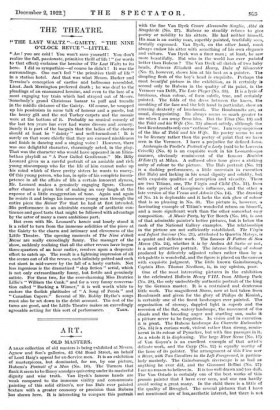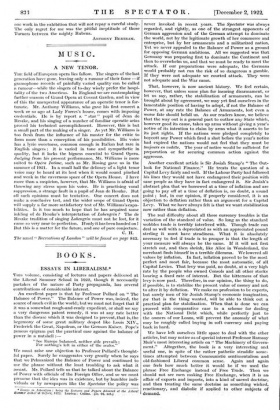ART.
OLD MASTERS.
A LOAN collection of old masters is being exhibited at Messrs. Agnew and Son's galleries, 43 Old Bond Street, on behalf of Lord Haig's appeal for ex-Service men. It is an exhibition of masterpieces, but dominated, for me, by one picture, Rubens's Portrait of a Man (No. 10). The Turners that flank it seem to be ffimsy smudges quivering under its masterful dignity and wise truth. Van Dyck's famous hands are 'weak compared to the immense virility and consummate ;painting of this solid citizen's, nor has Hals ever painted texture with a greater economy or precision than Rubens has shown here. It is interesting to compare this portrait with the fine Van Dyck Cesare Alessandro Scaglia, Abbi e:e Strap herde (No. 37). Rubens so steadily refuses to give poetry or nobility to his sitters. He had neither himself. His man is an earthy man, superbly painted, truthfully seen, brutally expressed. Van Dyck, on the other band, must always endow his sitter with something of his own elegance and culture. Van Dyck was a finer man ; at least, he saw more beautifully. But who in the world has ever painted better than Rubens ? The Van Dyck oil sketch of two baby heads, Princess Elizabeth and Henry, Duke of Gloucester (No. 2), however, shows him at his best as a painter. The dimpling flesh of the boy's head is exquisite. Perhaps the most beautiful picture in the exhibition, as it certainly is second only to Rubens in the quality of its paint, is the Vermeer van Delft, The Lute Player (No. 33). It is a lyric of luminous, clean colour, of form subtle, true, and certainly painted. The folds of the dress between the knees, the moulding of the face and the left hand in particular, show an amazing dexterity of brushwork. The Rembrandts are, as usual, disappointing. He always seems so much greater to me when I am away from him. But the Titus (No. 13) and the Tobit and his Wife (No. 35) almost satisfy, although the best Rembrandts only can" enthuse" me. lam very suspicious of the like of Tobit and his Wife. Its poetry seems to me to be literary rather than the poetry of paint that we have seen in the Vermeer. I have a prejudice for defined .form.
Ambrogio de Predis's Portrait of a Lady (said to be Luerezia Crivelli) (No. 8) is an exquisite work in his Leonardesque manner, obviously reminiscent of the famous Beatrice D'Este (7) at Milan. A suffused olive tone gives a striking unity of colour to the picture. The Ibis portrait (No. 12) is a dashing performance, a little uncertain in execution (for Hals) and lacking in his usual dignity and solidity, but with exquisite qualities of perception and vivacity. There are two Titians, one, The Virgin and Child (No. 31), from the early period of Georgione's influence, and the other a late version of the Venus and Adonis (No. 14). The drawing of No. 14 is deplorable and it lacks the rich glow of colour that is so pleasing in No. 31. The picture is, however, a fascinating example of Titian's wonderful return on himself, and a more significant work than the other somewhat easy composition. A Music Party, by Ter Borch (No. 18), is one of that admirable painter's better pictures, but is below the rank of the National Gallery examples. The relationships in the picture are not sufficiently established. The Virgin and Infant Saviour (No. 21), attributed to Quentin Matsys, is a quaint and delicate work. The famous II Fattore di San Marco (No. 24), whether it is by Andrea del Sado or not, is a most attractive portrait. The intense feeling of colour produced by delicately adjusted values rather than by a rich palette is wonderful, and the figure is placed on the canvas with exquisite judgment. The little known Gainsborough, Captain Hon. Thomas Needham, is, in my opinion, poor.
One of the most interesting pictures in the exhibition is the celebrated Holbein Henry VIII. from Althorp Park (No. 28), the only undoubtedly authentic portrait of the king by the German master. It is a restrained and dexterous little work. The magnificent Storm, now at last taken from Rembrandt and given for the glory of Philips de Konink, is certainly one of the finest landscapes ever painted. The organization of stormy, dappled light is superb and the recession of the flat, watery landscape, the movement of the clouds and the brooding anger and startling sun, make it a picture never to be forgotten. In vision and in execution it is great. The Rubens landscape La ChaiTette Embourbee (No. 15) is a curious work, violent rather than strong, remin- iscent in its colour of Pynacker, but with fine passages in it. As a whole it is displeasing. The large River Scene (No. 17) of Van Goyen's is an excellent example of that artist's delicate work, and the Cuyp (No. 32) is equally worthy of the fame of its painter. The arrangement of this View over a River, with Two Cavaliers in the Left Foreground, is particu- larly masterly. The Gainsborough riverscape is as bad as anything he ever did, and the Giovanni MUM (No. 27) I see no reason to believe in. It is too well drawn and too dull. The Van Ostade is certainly one of the best works of this prosaic painter that I have ever seen, and one can hardly avoid seeing a great many. In the child there is a little of the quality of Breughel. The several pictures that I have not mentioned are of leskaesthetic interest, but there is not
one work in the exhibition that will not repay a careful study. The only regret for me was the pitiful ineptitude of those Turners between the mighty Rubens.
ANTHONY BERTRAM.







































































 Previous page
Previous page